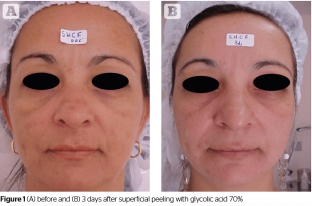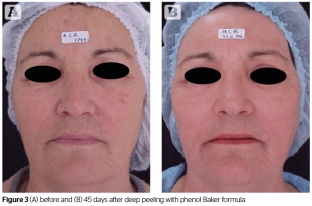The changes that occur in the skin during the aging process lead to dryness, sagging, thinning, as well as vascular changes and the appearance of wrinkles. Degeneration of elastic fibers and collagen, the appearance of age spots, precancerous and cancerous skin lesions – the result of a process known as photoaging. Non-localized oxidative damage is a consequence of UV exposure to the skin and leads to disruption of metabolic processes that also contribute to premature aging and skin cancer. Chemical peeling of the skin is aimed at accelerating the process of exfoliation and cell renewal through the action of chemicals, resulting in the skin looking younger.
 Professor Valcinir Bedin – Certified Dermatologist, Dean of the Faculty of Dermatology at the WBS Institute, São Paulo, Brazil
Professor Valcinir Bedin – Certified Dermatologist, Dean of the Faculty of Dermatology at the WBS Institute, São Paulo, Brazil
Chemical skin peels: general information and classification
Chemical skin peels are also called chemical resurfacing, chemoexfoliation or chemosurgery. The procedure consists in applying one or more caustic substances to the skin in order to cause controlled damage to the epidermis and its re-epithelialization. The popularity of this method is explained by the fact that it allows you to improve the appearance of skin damaged by external and internal factors, as well as get rid of residual scar tissue.

Fig. 1 Before (left) and after (right) superficial peeling with 70% glycolic acid
There are three types of chemical skin peels:
- surface;
- medium;
- deep.
Superficial chemical peeling of the skin: action and research
Superficial chemical peeling of the skin, usually epidermal. The risk of complications after such peeling in patients is minimal or completely absent. This type of peeling is performed on all skin types and areas of the body.
Substances used for superficial peeling:
- Jessner's solution (a combination of resorcinol, salicylic and lactic acids, and ethanol);
- solid CO2 (dry ice), usually used in case of acne;
- trichloroacetic acid (in concentrations of 10% & ndash; 35%);
- alpha hydroxy acids (lactic, maleic, citric, tartaric and glycolic acids).
Alpha hydroxy acids have different molecular sizes, the most powerful of them is glycolic – it penetrates the skin best and is good for getting rid of wrinkles, dryness and skin pigmentation. In the application of this acid, it is necessary to take into account not only the concentration, but also the pH value, which can vary from 2 to 4. The lower the pH value, the "acidic" the acid. substance, and the deeper the peeling acts. For a good effect of chemical skin peeling, the ideal pH value is 3.5. After peeling, to better protect the skin from the sun, it is necessary to use a sunscreen.
Studies by (1) Okano Y et al at Kobe University in Japan and (2) Omi T et al showed the following:
- Glycolic acid not only directly accelerates collagen synthesis by fibroblasts, but also modulates matrix degradation and collagen synthesis through cytokines secreted by keratinocytes. It has been confirmed that interleukin-1 alpha (IL-1 alpha) is one of the main mediators of matrix degradation released by keranocytes after exposure to glycolic acid. This allows UV-damaged skin to be repaired through different actions depending on the cell type.
- Chemical peeling of the skin with glycolic and lactic acid did not lead to changes in the stratum corneum and the upper layer of the epidermis, however, dissociation and vacuolization between basal cells was observed, and an increase in the number of vimentin filaments was observed in fibroblasts and endothelial cells. A study has shown that chemical peels using these substances directly increase collagen synthesis in the skin and stimulate skin remodeling.
Medium chemical skin peel: applied formulas
Medium chemical skin peel is used to get rid of:
- actinic keratosis;
- wrinkles;
- pigment spots;
- scars.
The classic chemical used for this type of peel was trichloroacetic acid at a concentration of 50%. However, on its own, it causes skin problems such as scarring and hypopigmentation. Therefore, it is combined with other active substances:
- glycolic acid;
- CO2;
- Jesser's solution.
Trichloroacetic acid acts on the epidermis and dermis, exfoliation and destruction of the stratum corneum occurs.

Fig. 2 (A) before and (B) 30 days after mid-peeling with Jessner's solution and trichloroacetic acid 35%
Another familiar combination is 70% glycolic acid and 35% trichloroacetic acid.
Deep chemical skin peel: Baker formula
Deep chemical peeling of the skin penetrates into the deepest layers of the skin. The most famous representative of such peels is phenol. It leads to the coagulation of skin proteins and allows you to achieve intense rejuvenation (if used correctly). In minimal concentrations up to 1%, phenol has a bacteriostatic effect. Higher concentrations of this substance have a bactericidal effect. Phenol acts as a local anesthetic on the nerve endings of the skin. As a chemical compound, phenol dissolves in fats and oils. In case of accidental contact with the skin, it is removed with glycerin, vegetable oils or 5% ethyl alcohol.

Fig. 3 (A) before and (B) 45 days after Baker's deep phenol peel
The most famous formula for deep chemical skin peeling is the Baker-Gordon formula (1962), in which the concentration of phenol varies between 45 & ndash;55%.
Baker-Gordon Formula
- Component %
- Phenol, 88% 50
- Demineralised water 44
- Croton Oil 4.5
- Liquid Soap 1.5
Croton oil enhances the ability of phenol to coagulate keratin as it promotes penetration into the skin, increasing the vascularization of the treated area. The biological activity of this oil is due to free hydroxyl groups. Croton oil is toxic to the skin and causes swelling and redness. It is insoluble in water and highly soluble in alcohol and benzene.
The liquid soap in this chemical skin peel formula acts as a carrier medium and reduces the surface tension of the fat in the skin. It facilitates the penetration of phenol into the skin and ensures uniform peeling.
Water is the medium used to achieve the desired concentration of phenol in the formula. Moy et al note that the intense and deep action of Baker's Peel is due to a combination of ingredients in the formula that increases the penetrating and irritating power of the phenol.
Baker's formula is a suspension, it is formed by small particles of a solid dispersed in a liquid medium. Shake the formula before use to ensure uniform application and effectiveness of the procedure.
Phenol at a concentration of 88% penetrates into the upper reticular layer of the dermis. Phenol, dissolved in the formula, acts as a keratolytic: it destroys the sulfur bridges of keratin and penetrates deeper. The higher the concentration of phenol in the formula, the greater the coagulation of keratin, and the less its toxicity. When applied to the skin, phenol causes a chemical burn that leads to skin rejuvenation over time. Application for a longer period provides penetration into the upper layers of the dermis, resulting in the formation of a new layer of collagen. Epidermal regeneration begins 48 hours after application of the formula and is completed after 7-10 days.
Deep chemical peeling of the skin is used in the following cases:
- for skin whitening;
- to get rid of wrinkles;
- for hyperpigmentation or heterogeneous pigmentation;
- acne scars;
- scars;
- actinic lentigo.
Complications after chemical skin peels
Complications are more common after deep chemical skin peels, however, in some cases, they are also observed with less deep penetration of chemicals into the skin.
- Pigmentation changes may occur as a result of an inflammatory process;
- hypopigmentation occurs as a result of the toxic effect of phenol on melanocytes, but this complication is quite rare;
- Change in skin pigmentation varies depending on the patient's skin type;
- lower eyelid eversion;
- infection caused by microorganisms Staphylococcus sp,Streptococcus sp and Pseudomonas aeruginosa ;
- redness after deep peeling that does not go away for 2-4 months;
- appearance of scars (on lips, eyelids, lower jaw);
- appearance of milia due to rapid re-epithelialization of the skin.
To minimize the chance of complications after chemical skin peels, the procedure must be carried out carefully and take into account the characteristics of the patient's skin type.
According to Prime magazine.







Add a comment